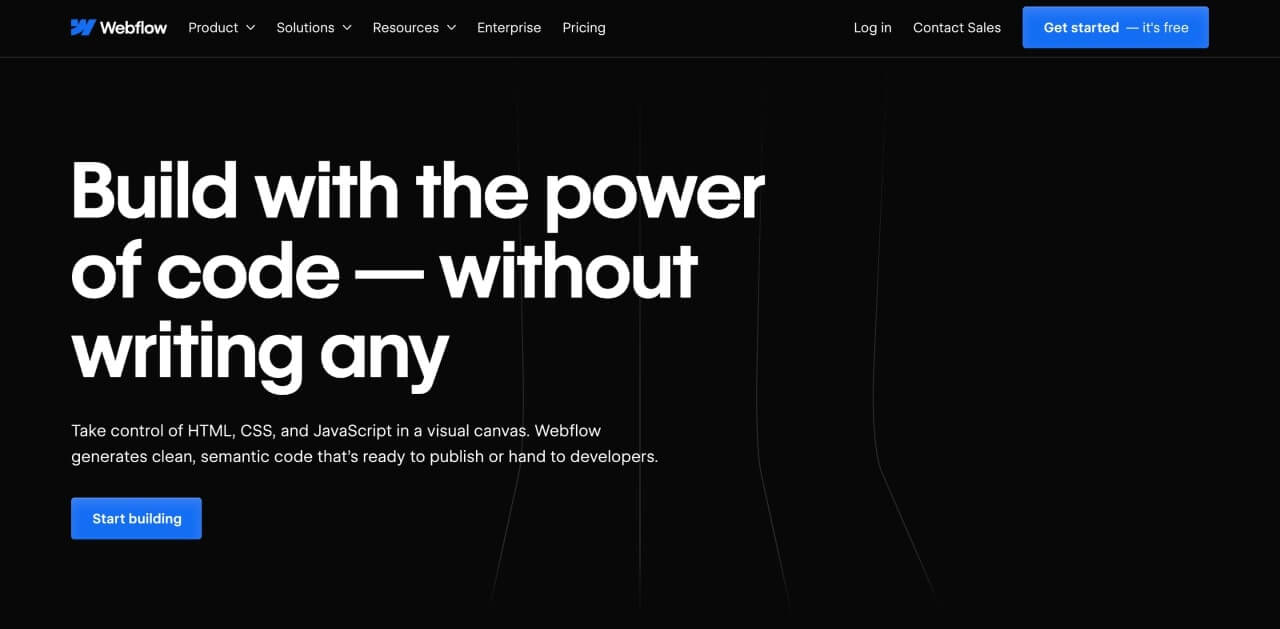Earn with Printify – your 5% commission awaits
56% of professional content creators in the United States say affiliate marketing is one of the most common channels to generate income after sponsored posts.
Sounds good, right? While joining affiliate programs is relatively easy, earning money online using your own website takes some preparation.
Learning how to create a website for affiliate marketing may sound complex. But with our step-by-step instructions, you’ll be on your way to earning passive income with affiliate marketing in no time.
Follow our comprehensive guide to build a stable revenue stream with an affiliate marketing website today.
This post may contain affiliate links, which means we may earn a commission if you make a purchase through those links. This comes at no additional cost to you.
1. Choose a platform based on your niche
First things first – you need to find your own unique niche. This is a specific area within a broader market that your affiliate website will focus on.
Consider topics that align with your interests, hobbies, or professional expertise, as this will make it easier to create engaging content and authentic connections with your audience.
Some of the best niches have low competition but consistent demand.
Once you have a niche in mind, select a platform that connects you to your audience, offers all the customization features you need, and helps you promote products and services online.
We’ll go through some of the most popular options.
WordPress

WordPress is ideal for blogs and content-heavy sites. With customizable content structures, a wide range of themes, and plugins, creating a unique and engaging affiliate marketing website for your chosen niche is easy.
There are multiple WordPress plugins specifically for affiliates. Start by checking out SliceWP or Coupon Affiliates for all the tools you’ll need to manage and grow your affiliate business.
You can create a free self-hosted affiliate website on wordpress.org, but you’ll need to find web hosting. Or go with wordpress.com, which has hosting and both free and paid plans with prices starting at $4 per month or $48 annually.
Wix

Its intuitive interface and customizable features make it easy to launch an affiliate marketing website and create engaging content that drives conversions and maximizes your revenue potential.
Wix offers over 900 templates, AI design for custom site creation, and built-in search engine optimization (SEO) tools.
There’s also a Wix Affiliate Program where you can earn commissions from referrals that purchase a Wix Premium Plan.
Wix offers free and paid premium plans ranging from $17 to $159 per month.
Shopify

Perfect for hosting an affiliate blog and eCommerce store, Shopify offers 171 paid and 12 free themes. Plus, they have over 8,000 vetted apps, various built-in marketing tools, and fast order checkout.
Add affiliate links to your product listings using the Add to cart button to direct visitors to your partner’s page.
Shopify also offers an affiliate program. Join Shopify Affiliates to earn commissions from all full-price plan affiliate link referrals.
Pricing plans range from $29 to $399 per month. Sign up for a free three-day Shopify trial to see if this platform works for your affiliate marketing business, and enjoy your first month for just $1.
Quick tip
Explore our list of the best free Shopify themes to find the perfect design for your affiliate website.
Squarespace

With eye-catching design aesthetics and various eCommerce features, Squarespace is an excellent choice for affiliate marketers aiming to adapt their brand to target a specific niche.
Squarespace offers 168 templates and the option to build your own. They provide a curated list of extensions, built-in SEO, audience insights, marketing tools, and a free domain name for the first year.
There’s also a Squarespace Affiliate Program where you can earn commissions from all referral purchases.
Pricing starts at $23 per month or $16 if paid yearly for the personal plan. For the eCommerce functionality, this goes up to $65 monthly or $49 if paid annually.
Webflow

This no-code website builder is perfect for creating a custom-designed website to showcase a unique brand vision.
Webflow offers hosting, one-click publishing, built-in SEO tools, along with many customization features and control over the content and layout of your website.
There’s also an affiliate marketing program – join Webflow Affiliates to earn commissions from your affiliate link for Webflow subscriptions.
The starter plan is free. General paid plans range from $14 to $39 per month if paid yearly, while eCommerce plans range from $29 to $212 per month, also billed annually.
If you’re interested in combining your affiliate marketing efforts with selling your own Print on Demand products, check out our integrations:
Make it happen today!
2. Get a domain name and decide on hosting

Now that you’ve chosen a platform, it’s time to secure a domain name and find a reliable hosting provider. This part will be easy if you go with any of the platforms we’ve looked at.
Register a domain name
Your domain name is your website’s URL that allows internet users to find and access your site easily.
A good domain name is
- short,
- easy to spell,
- with no special characters,
- and only consists of up to four words.
All the platforms we looked at have the option to buy a domain, with Squarespace offering a domain name for the first year at no extra cost and Wix giving out a free domain voucher.
Alternatively, try Namecheap to see what domains are available at affordable prices.
While free options may seem appealing, investing in a unique domain name can make your affiliate marketing site seem more professional and trustworthy.
Find a web host
Your web host is a service that stores and publishes your website on the internet, making it easily accessible to visitors worldwide.
Good web hosting means
- reliable servers,
- fast site speed,
- strong security,
- helpful support,
- and flexible hosting plans to accommodate your website’s growth.
All of the platforms we’ve listed offer hosting, apart from wordpress.org.
Check out Namecheap’s reliable and affordable hosting options. Plans start at $1.58 per month, paid every two years.
3. Design and fill out your affiliate website

Choose a theme or design individual elements
Opt for a premade theme for a speedy setup, or create your own to ensure a truly one-of-a-kind design.
Go through the themes offered on your chosen platform and select one that best suits your affiliate marketer goals and aligns with your brand image.
Use drag-and-drop features to rearrange key site elements easily.
Add
- promotional banners for affiliate products,
- eye-catching graphics to highlight special offers,
- and engaging images or videos relevant to your niche.
If you want complete control over the appearance of your website, design each element separately using an AI website builder.
Must-have pages
All successful affiliate marketing websites need structure and transparency.
From introducing your brand to outlining key policies, these are the essential pages you’ll need to add to your affiliate website:
- Home page. This is your website’s front door. Invite site visitors to explore your content and find what they’re looking for, which, in your case, should be affiliate links.
- Contact page. Provide your site visitors with an easy way to contact you in case they have any questions. A contact page enhances your website’s credibility by showing that the content creator is just a few clicks away.
- About page. Introduce yourself and share your affiliate marketer story with your audience.
Highlight your reasons for starting an affiliate marketing website, like your passion for the niche or your desire to provide valuable information to others. - Terms and conditions. Establish the rules for using your website, covering user responsibilities, intellectual property rights, and disclaimers.
Be sure to disclose your affiliate partnerships. If you’re running a WordPress site, use the WP Affiliate Disclosure plugin to simplify the process.
Quick tip
Check out our guide on writing an affiliate disclosure for your affiliate marketing website.
- Privacy policy. Add information on how user data is collected and stored, detailing the mechanisms and protocols in place to safeguard all personal information.
Include statements regarding compliance with relevant privacy laws like the California Consumer Privacy Act (CCPA) or the General Data Protection Regulation (GDPR).
4. Create content and implement SEO

Engaging content and SEO are the backbone of any successful affiliate marketing strategy – they drive internet users to your site.
Create high-quality content
Attract organic traffic to your website and establish yourself as a trusted authority in your niche by creating valuable and relevant content that resonates with your audience.
- Publish various types of content. Share well-written articles and blog pieces, create captivating social media posts, and upload entertaining and informative videos.
- Keep to a schedule. Regularly publish content to keep your audience engaged, but don’t oversaturate your feeds. Find the perfect balance by following a schedule.
- Write guest posts. Contribute your original content to other websites that are relevant to your niche.
- Collaborate with influencers. Work with influencers in your niche to expand your reach and attract a broader audience to your content.
Apply SEO techniques to attract visitors
Combine creating content with an effective SEO strategy to maximize your affiliate website’s visibility, drive organic traffic, and, ultimately, increase your affiliate revenue.
Use these tips to optimize on-page elements of your affiliate marketing website:
- Double-check and fix your links. Use clean and short URLs and ensure that both internal and external links on your website are functional and lead to the intended destinations.
- Add metas. Write short and engaging meta descriptions and titles for each page to drive clicks from search engine results. Also, be sure to include relevant keywords.
- Add alt texts. Add descriptive alt texts for all images shared on your website to improve accessibility and provide context for users who rely on screen readers. Briefly describe the content and purpose of each image and incorporate keywords where possible.
- Edit page structures. Organize your website pages and every blog post by adding clear headings (H1, H2, and H3) to improve readability and navigation for both human site visitors and search engine crawlers.
Important technical aspects will also affect SEO, like fast loading speeds and mobile compatibility, which your chosen platform and hosting provider will handle.
Quick tip
Go through our guide on affiliate marketing keyword research for ideas on optimizing your content to rank higher in search engine results.
5. Promote your affiliate marketing website

Email marketing
Build an email list of subscribers and start creating content to share with your readers on a regular basis.
Use email marketing tools to automate email campaigns and customer segmentation to personalize emails and ensure better engagement.
Come up with a list of custom content ideas to share with each group of subscribers, and be sure to include great deals and affiliate offers in your emails.
Quick tip
Check out our blog on how to create a mailing list for your online store.
Social media marketing
Use popular social media platforms like Facebook, Instagram, X, and TikTok to promote your affiliate marketing website or even as your main platform for sharing affiliate links.
Create engaging content, interact with your audience, and run targeted ads to grow your follower count.
- Register on all relevant social media platforms. Create profiles on more than one platform – ideally, all those your target audience uses.
Quick tip
Explore ways to make money as an influencer.
- Share valuable content. Post reviews, how-to guides, testimonials, and industry updates that are specifically tailored to your niche.
- Talk to your audience. Interact with your followers by promptly adding reactions and responding to comments, messages, and mentions, cultivating a sense of community.
- Monitor the entire process. Track user engagement and click-through rates to fine-tune your approach and enhance your results.
Search engine marketing
Creating quality content is key to attracting visitors to your affiliate marketing website. However, there are a few other essential strategies to follow that ensure your visibility in search engines:
- Carry out keyword research. Drive organic traffic to your website by identifying relevant keywords related to your niche and adding them to your content.
- Focus on link building. Build backlinks (links that take you from one website to another) from reputable websites to improve your site’s authority and search engine ranking.
- Use paid advertising. Consider using pay-per-click advertising platforms like Google Ads to target specific keywords and lead visitors from search engines directly to your site.
Join the Printify affiliate program
Become a Printify Affiliate to earn a 5% commission from each sale.
How to create an affiliate marketing website: Key takeaways

To make your affiliate marketing journey successful, you’ll likely need to join multiple affiliate programs. You’ll also need to put some hours aside for website creation, brand building, and marketing.
How to create a free website for affiliate marketing?
- Choose a Platform Based on Your Niche
- Get a Domain Name and Decide on Hosting
- Design and Fill out Your Affiliate Website
- Create Content and Implement SEO
- Promote Your Affiliate Marketing Website
Affiliate marketing won’t make you rich overnight, but following these tips can bring you closer to your goal of seeing affiliate revenue pouring into your bank account.
Join the Printify Affiliate program and earn passive income from every sale your well-written content and promotions generate.
Join the Printify affiliate program
Become a Printify Affiliate to earn a 5% commission from each sale.












